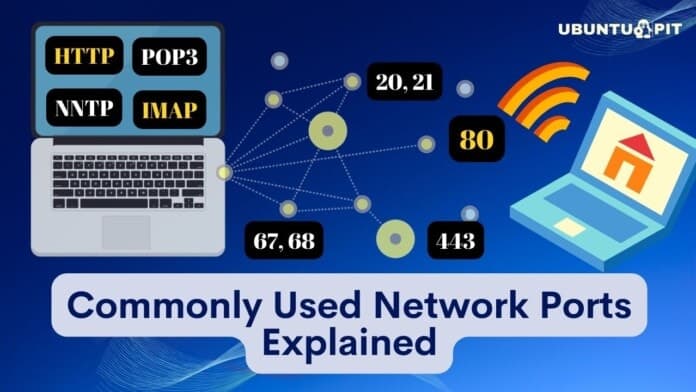Network ports are the communication point where you can use a single IP address with different ports for different usages. They can be both dynamic, private, and registered. If you’re a network admin or a Linux admin, you must know the importance of network sockets. Network ports are crucial for database engineering, CCNA, and logical operations. The invention of the networking ports has made computer communications more straightforward and more convenient. If you want to be an expert and professional network engineer, you must know the commonly used network ports.
Commonly Used Network Ports
Here you can see the difference between ports for different types of web access. When you browse the internet on the HTTP sites, the typical network port is 80; on the other hand, the common port for the HTTPS sites is 443. In the same way, when you browse to an FTP site, secure online shell, or a DNS server, the ports get changed. In this post, we will see the commonly used network ports.
1. File Transfer Protocol (FTP) Network Port: 20
The FTP or the file transfer protocol is used for FTP movie servers, local file sharing, and data transferring. These ports are assigned under the TCP protocol, and the FTP ports come under the application layer under the OSI model. We can commonly use the network port 20 for FTP servers.

2. File Transfer Protocol (FTP) Command Control: 21
Network admins and Linux experts mostly use the command-line-based FTP server. The CLI-based FTP also comes under the TCP protocol and application layer. For the command line-based file transfer protocol services, we can use the network for 21.
The data transfer rate over the network port 21 is faster than the network port 20 that we have seen previously. As we are using the command-line-based FTP server, the network port 21 is also secure to use.
3. Secure Shell (SSH) Secure Login: 22
The SSH or the secure shell-based communications totally rely on the network port 22. The network system administrator mostly uses this function for using the remote access control over the system.
You can use the network port 22 for secure shell, logins, remote file transfer, and port forwarding if you are a network engineer. Port 22 comes under the application layer under the OSI networking model, which is a TCP port.
4. Telnet Remote Login Service: 23
Most network and system engineers use port 23 for Telnet protocol and remote maintenance. Port 23 also comes under the TCP protocol, and this is also an application layer where you can use this port to remote access devices through the network. The main difference between port 22 and port 23 is the connection over port 23 is unencrypted.
5. Simple Mail Transfer Protocol (SMTP) Email Delivery: 25
Port 25 is another most commonly used network port for simple mail transfer protocol for SMTP. If you intend to build your own mail delivery system for a server for your Linux system, you can securely use port 25 in your network system. The SMTP protocol 25 also comes under the application layer from the OSI model, and it is assigned as a TCP protocol port.
6. Domain Name System (DNS) Service: 53
All are familiar with and as are the domain name systems. The DNS servers are used for accessing the internet using the web address instead of using the actual IP address of the internet web services. The DNS service port number 53 comes under the UDP protocol in the networking system.
7. DHCP Network Ports: 67, 68
The Dynamic host configuration sockets 67 and 68 come under the UDP protocol that clients can use. You can also do DHCP operations with ports 67 and 68. These are also application layer ports under the OSI model of networking.
8. Hypertext Transfer Protocol (HTTP) Network Port: 80
The HTTP or the hypertext transfer protocol is one of the most known and most used network ports among users. When you make a local host server or build your own server, you can use your fault or local IP address with the port 80. This is an application layer port that comes under both TCP and UDP.
9. Post Office Protocol (POP3) Network Port: 110
The network port 110 is actually a commonly used TCP socket in networking, but you can also assign this socket as a UDP socket. Network engineers mostly use this socket for post office protocols for handling electronic mail over a server or local network. This POP3 port is an application layer port.
10. Network News Transfer Protocol (NNTP): 119
The NNTP or the Network News Transfer Protocol is similar to the POP3 network port. The NNTP 119 networking socket also comes under the TCP application layer socket. Mostly, this port is used for reading online news and articles.
11. Network Time Protocol (NTP): 123
The Network Time Protocol or the NTP is a TCP protocol socket in networking. In Ubuntu and other Linux machines, the NTP ports are used used to always get you the right time from your desired internet clock. This NTP port is used widely for both Linux and Windows systems to establish connections with best time servers.
12. Internet Message Access Protocol (IMAP): 143
The IMAP, or the internet message access protocol, has two significant versions they are IMAP and IMAP4. These ports are mostly used and managed by the same port 143. The network socket 143 is widely famous for handing emails, internet messages, and web-mails securely. This socket is also an application layer port under the OSI model of networking.
13. Simple Network Management Protocol (SNMP): 161
The name of the SNMP, or the Simple Network Management Protocol, defines many of its working areas. The SNMP socket 161 is one of the most commonly used network sockets for monitoring and handling networking devices on your local area network. It can function as a manager to receive and send commands to the network devices.
14. Internet Relay Chat (IRC) Network Port: 194
The IRC port 194 has a few versions for handling the internet relay chats. It can be used in both TCP and UDP protocols. The usage of the IRC port has increased a lot over the last two years. You will need root access on your machine to run the internet chats over the IRC port 194. Users can use it with both TSL/SSL. You can also use the IRC 194 port for managing the plaintext protocols.
15. HTTP/HTTPS Network Ports For TLS/SSL: 443

HTTP or HTTPS is the most common word in the world of networking. From professionals to newbies, all types of users are aware of this the TLS/SSL 443 networking socket. This port is commonly used for loading the most common websites with SSL or NoSSL certificates. This socket works in both public and private networks.
Insights!
The network sockets are mostly divided into two major protocols they are the TCP and UDP socket numbers. The TCP means Transmission Control Protocol (TCP), and the UDP means User Datagram Protocol (UDP), both of these two protocols can be accessed or used from every network protocol. You can use TCP or UDP ports for the same sockets in higher-level protocols.
Before us any network sockets on your network, you should check whether the socket is closed or open in your local connection. You can also check the firewall settings to allow the network on your system. In the entire post, we have seen the most commonly used network ports.
I hope this post has been valuable and informative for you. If yes, please share this post with your friends and the Linux community. You can also write down your opinions about this post in the communication section.
